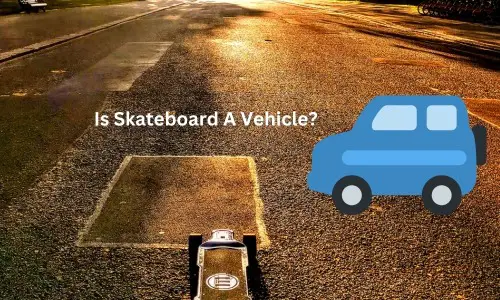Is Skateboard a Vehicle? [All You Need to Know]
( If you purchase through our sponsored links, we may receive a small commission at no extra cost to you )
Skateboarding has been a popular recreational activity for decades, and many people use it as a form of transportation. But, is a skateboard a vehicle? The answer is not as clear-cut as one might think.
Some argue that skateboards have wheels and are propelled by human power, making them a form of transportation and therefore a vehicle. Others argue that skateboards lack certain characteristics that define a vehicle, such as an engine or motor.
In this article, we will explore both sides of the argument and determine whether or not a skateboard can be classified as a vehicle.
Definition of a Vehicle
A vehicle is a device used for transportation that moves people or goods from one place to another. It can be powered by an engine, motor, or other means of propulsion. Vehicles are used for various purposes, such as commuting, delivery, transportation of goods, and recreation.
So, according to the 1st line of transportation, a skateboard can be called a vehicle as vehicle is used for transportation. But in the 2nd line, we see that it is talking about engine and motor. According to this, skateboard cannot be called a vehicle. But, electric skateboard can be called vehicle as it uses motor.
Characteristics of a Vehicle
The characteristics of a vehicle can include the method of propulsion, capacity for transporting people or goods, use on public roads or private property, and compliance with traffic laws and regulations.
Different Types of Vehicles
There are many different types of vehicles, such as cars, trucks, buses, motorcycles, bicycles, boats, and planes. Each type of vehicle has its own specific characteristics and uses, but all are designed for transportation in some form.
Vehicles can also be classified based on their power source, such as gasoline, electric, or hybrid engines.
Wikipedia Definition of Vehicle
A vehicle (from Latin vehiculum)[1] is a machine that transports people or cargo. Vehicles include wagons, bicycles, motor vehicles (motorcycles, cars, trucks, buses, mobility scooters for disabled people), railed vehicles (trains, trams), watercraft (ships, boats, underwater vehicles), amphibious vehicles (screw-propelled vehicles, hovercraft), aircraft (airplanes, helicopters, aerostats) and spacecraft.[2]
Land vehicles are classified broadly by what is used to apply steering and drive forces against the ground: wheeled, tracked, railed or skied. ISO 3833-1977 is the standard, also internationally used in legislation, for road vehicles types, terms and definitions.[3] (Credit: Wikipedia)
My Point of View on Vehicle
I would still depend on the above wikipedia definition and would not say skateboard is a vehicle. To me, any transportation can be a vehicle if it is a machine. To me, skateboard is not a machine. But, to some sort, electric skateboard can be a called a vehicle if you can see the parts of a electric skateboard, having motor and other electric parts.
According to my 11-year-old son Areeb, he considers his penny board as a mode of transportation, i.e. vehicle which he uses to move from one room to another within house. Therefore, he views his skateboard as a vehicle for his daily transportation needs within his immediate environment.
Arguments in Favor of Skateboards Being Vehicles
In this section, we will examine the arguments in favor of skateboards being classified as vehicles, including their ability to transport people, their use of wheels and human power, and their potential for use on public roads.
Skateboard is Transportation
One of the primary functions of a vehicle is to transport people or goods from one place to another. Skateboards, while primarily used for recreation, can also be used as a mode of transportation.
Skateboarders use their boards to travel short distances, such as between classes on a college campus or to a nearby store. In fact, some people use skateboards as their primary mode of transportation, especially in urban areas where traffic congestion and limited parking can make driving a car less practical.
While skateboards may not be as efficient as other forms of transportation, such as cars or bicycles, they are still capable of transporting people from one place to another.
This ability to move people from one location to another is a key characteristic of a vehicle and supports the argument that skateboards should be considered a form of transportation and therefore, a vehicle.
Skateboards have Wheels and are Propelled by Human Power
Propulsion is another characteristic of a vehicle. Most vehicles are powered by an engine, motor, or other means of propulsion. However, some vehicles, such as bicycles, are propelled by human power.
Skateboards are also propelled by human power and have wheels, which are another key characteristic of vehicles.
Skateboarders use their feet to push and propel their boards forward, allowing them to move at varying speeds depending on the terrain and their skill level.
The use of wheels and human power to move the skateboard aligns with the characteristics of a vehicle, which requires some means of propulsion to move from one place to another.
Therefore, the fact that skateboards have wheels and are propelled by human power is an argument in favor of classifying them as vehicles, since they possess the key characteristics of a vehicle.
Skateboards is Transportation on Public Roads
One of the key factors in determining whether something is a vehicle is its potential for use on public roads. Most vehicles are designed and used for transportation on public roads, which are regulated by traffic laws and regulations. Skateboards, while primarily used for recreation, can also be used for transportation on public roads.
In many cities and urban areas, skateboarders use their boards to navigate streets and sidewalks, sometimes traveling alongside motor vehicles and bicycles.
While it is true that many laws and regulations do not explicitly consider skateboards to be vehicles, the fact that they can be used for transportation on public roads supports the argument that they should be classified as vehicles.
Furthermore, some cities and municipalities have explicitly allowed or even encouraged the use of skateboards on public roads, and have developed specific laws and regulations to govern their use.
This recognition and accommodation of skateboards as a form of transportation reinforces the argument that they should be classified as vehicles.
Therefore, the fact that skateboards can be used for transportation on public roads supports the argument that they should be classified as vehicles, given their potential to function in the same way as other vehicles on the road.
Arguments against Skateboards Being Vehicles
While there are several arguments in favor of classifying skateboards as vehicles, there are also compelling arguments against this classification.
Some argue that skateboards lack certain characteristics that define a vehicle, such as a motor or engine, and that they are primarily used for recreation rather than transportation.
In this section, we will examine the arguments against classifying skateboards as vehicles, including their limited speed and range, their lack of protection for the rider, and their potential to disrupt pedestrian traffic.
Skateboards are not Classified as Vehicles under Traffic Laws
In most jurisdictions, traffic laws and regulations define what constitutes a vehicle and how they should be used on public roads. While bicycles, cars, and other modes of transportation are specifically defined as vehicles, skateboards are not.
Without this classification as a vehicle, skateboarders are not subject to the same traffic laws and regulations that apply to other vehicles, such as speed limits and traffic signals.
This lack of regulation has the potential to create safety issues for both the rider and other road users.
Therefore, the argument against classifying skateboards as vehicles under traffic laws is based on the lack of recognition and regulation by traffic laws, which leads to the potential for safety issues on public roads.
Skateboards do not have Engines or Motors
One of the main characteristics that define a vehicle is the presence of an engine, motor, or other means of propulsion. Unlike cars, motorcycles, and other vehicles, skateboards do not have an engine or motor. They are propelled solely by the rider’s body and movement.
This lack of an engine or motor means that skateboards are fundamentally different from traditional vehicles, which rely on mechanical or electrical means of propulsion. As a result, many argue that it is inappropriate to classify skateboards as vehicles.
While skateboards do have wheels and can be used for transportation, they are primarily used for recreation and do not share the same features and capabilities as other vehicles on the road.
This difference in functionality and design is a key argument against classifying skateboards as vehicles.
Therefore, the argument against classifying skateboards as vehicles based on the absence of an engine or motor highlights the fundamental differences between skateboards and traditional vehicles, making it difficult to classify them as the same type of object.
Skateboards are not Designed for Transportation on Public Roads
Another argument against classifying skateboards as vehicles is that they are not primarily designed or intended for transportation on public roads.
While it is true that some skateboarders use their boards to navigate streets and sidewalks, the primary use of a skateboard is for recreation and sport.
Unlike bicycles or cars, skateboards lack features that make them suitable for transportation on public roads, such as lights, brakes, and other safety features.
Additionally, their relatively small size and limited speed and range make them less practical for longer-distance transportation.
Given their primary function as recreational equipment, some argue that it is inappropriate to classify skateboards as vehicles, and that doing so could lead to confusion and safety issues on public roads.
Therefore, the argument against classifying skateboards as vehicles based on their design and intended use highlights the fact that skateboards are not primarily intended for transportation on public roads, but rather for recreational purposes.
Legal Implications
- Traffic laws and regulations: If skateboards are classified as vehicles, they would be subject to the same traffic laws and regulations as other vehicles on public roads, including speed limits, stop signs, and traffic signals.
- Requirements for registration and insurance: If skateboards are classified as vehicles, they may be required to be registered and insured, similar to cars and motorcycles.
Safety Implications
- Protective Gear Requirements: If skateboards are classified as vehicles, riders may be required to wear protective gear, such as helmets, to comply with safety regulations and reduce the risk of injury in the event of an accident.
Therefore, the implications of classifying skateboards as vehicles include potential legal and safety requirements that could impact the way they are used and regulated on public roads.
Restrictions on where Skateboards can be Used
If skateboards are classified as vehicles, there may be restrictions on where they can be used. Just like other vehicles, there may be certain roads or areas where skateboards are not allowed to be used, such as highways, interstates, or other areas with high speed limits or heavy traffic.
Additionally, there may be restrictions on where skateboards can be used in public spaces, such as sidewalks or parks. Some cities and municipalities have already implemented laws and regulations that limit or prohibit skateboarding in certain areas or during certain times of the day to ensure safety and prevent damage to property.
If skateboards are classified as vehicles, these restrictions may become more widespread and enforced more strictly, leading to potential limitations on where and how skateboards can be used.
Therefore, if skateboards are classified as vehicles, it may lead to more restrictions on where they can be used, potentially limiting the ability of riders to enjoy them in certain areas or public spaces.
Speed of A Skateboard
The average speed of a skateboard is approximately 9 miles per hour, taking into consideration various factors such as skill level, type of terrain, and equipment setup. Typically, the speed range for skateboarding falls between 5 to 12 miles per hour, which includes a variety of styles and preferences.
Skilled skateboarders often commute short distances of 1-2 miles on flat surfaces, maintaining an average speed of 7-8 miles per hour. The cruising speed for skateboarding typically ranges between 5-7 miles per hour.
To calculate the speed of the skateboard, take the help of this speed calculator.
Implications on Speed of Skateboard
It is important to note that the speed at which one rides a skateboard should be influenced by safety concerns and the surrounding environment. Skateboarders must remain alert and vigilant, adhering to traffic regulations and taking precautionary measures to avoid accidents.
The speed of a skateboard does not determine whether or not it is considered a vehicle. Skateboards are generally considered a type of vehicle, regardless of their speed.
However, the speed at which a skateboard is ridden may be subject to certain regulations or restrictions in certain areas. For example, some cities may have specific speed limits for skateboarders in certain areas, such as busy pedestrian zones or near schools.
In general, skateboarders are expected to use good judgment and ride at a safe and reasonable speed, taking into account their surroundings and the potential for hazards or obstacles in their path.
It is important for skateboarders to follow the same rules of the road as other vehicles, including obeying traffic signals and yielding to pedestrians when necessary.
Overall, while the speed of a skateboard may be subject to certain regulations or restrictions in some areas, it does not determine whether or not it is considered a vehicle.
Skateboarders should prioritize safety and be aware of their surroundings when riding in public spaces.
Different Types of Skateboards and Are They Vehicles?
- Longboards: Longboards are longer and wider than traditional skateboards and are designed for cruising or transportation rather than tricks or maneuvers.
While some longboards may be used for transportation, they are not typically equipped with features like lights or brakes that would make them suitable for use on public roads. Therefore, it is unlikely that longboards would be classified as vehicles.
- Electric skateboards: Electric skateboards are similar to traditional skateboards but are equipped with an electric motor that propels the board.
Some electric skateboards are designed for use on public roads and can reach higher speeds than traditional skateboards making it a vehicle.
If electric skateboards are used on public roads, they may be subject to the same traffic laws and regulations as other motorized vehicles, and may be required to be registered and insured.
- Penny boards: Penny boards are small, lightweight skateboards that are designed for portability and maneuverability. While some riders may use penny boards for transportation, they lack features like lights or brakes that would make them suitable for use on public roads.
Therefore, it is unlikely that penny boards would be classified as vehicles.
In summary, while some types of skateboards may be used for transportation, they may lack the features necessary to be classified as vehicles under traffic laws and regulations.
Electric skateboards may be an exception, as they are equipped with motors and may be subject to motor vehicle regulations if used on public roads.
Frequently Asked Questions
What is a skateboard called?
Ans: A skateboard is a type of sports equipment that is used for recreational or competitive activities. It is also sometimes referred to as a “skate” or a “deck.” The skateboard typically consists of a flat board made of wood or other materials, with four small wheels mounted on the underside.
The rider stands on the board and propels themselves forward by pushing off the ground with one foot while keeping the other foot on the board.
Do skateboard riders need to wear protective gear, such as helmets?
Ans: Skateboarding can be a fun and exhilarating activity, but it also comes with potential risks such as falls and collisions.
Wearing protective gear such as a helmet, knee pads, elbow pads, and wrist guards can help reduce the risk of injury and protect skateboarders from harm. It is important for skateboarders to prioritize safety and take the necessary precautions to prevent accidents and injuries.
Can electric skateboards be considered vehicles?
Ans: Yes, electric skateboards can be considered vehicles in certain contexts. In some jurisdictions, electric skateboards are subject to the same regulations and restrictions as other motorized vehicles, such as speed limits and rules of the road.
However, the specific classification of electric skateboards may vary depending on local laws and regulations. It is important for riders of electric skateboards to familiarize themselves with the applicable regulations and to ride safely and responsibly.
Is it legal to ride a skateboard on the sidewalk?
Ans: The legality of riding a skateboard on the sidewalk may vary depending on the specific location and local regulations.
In some areas, it may be legal to ride a skateboard on the sidewalk as long as the rider is following traffic laws and not endangering pedestrians. However, in other areas, skateboarding on sidewalks may be prohibited or restricted to certain areas.
In general, skateboarders should be aware of their surroundings and ride safely and responsibly, taking into account the potential for hazards and the presence of pedestrians.
It is important to follow all applicable regulations and to be respectful of others sharing the same space..
Conclusion
In conclusion, the question of whether skateboards should be classified as vehicles is not a simple one.
While there are arguments in favor of skateboards being classified as vehicles, such as their ability to transport people and be used on public roads, there are also arguments against this classification, including the lack of engines or motors and their limited design for transportation.
The implications of classifying skateboards as vehicles, such as legal and safety requirements and restrictions on where they can be used, should also be carefully considered.
Ultimately, the classification of skateboards as vehicles is dependent on a variety of factors and may vary depending on the specific type of skateboard and how it is used.





![12 Best Skateboard Books In 2023 [Must Read & Listen!]](https://sportstotry.com/wp-content/uploads/2020/02/SKATEBOARDING-BOOKS.jpg)

![How to Carry a Skateboard? [5 Excellent Ways]](https://sportstotry.com/wp-content/uploads/2022/05/How-To-Carry-A-Skateboard.jpg)